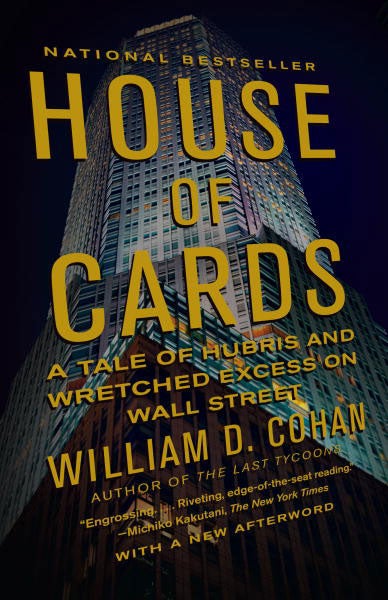
House of Cards
by William D. Cohan
NATIONAL BESTSELLER
With a New Afterword
A blistering narrative account of the negligence and greed that pushed all of Wall Street into chaos and the country into a financial crisis.
At the beginning of March 2008, the monetary fabric of Bear Stearns, one of the world’s oldest and largest investment banks, began unraveling. After ten days, the bank no longer existed, its assets sold under duress to rival JPMorgan Chase. The effects would be felt nationwide, as the country suddenly found itself in the grip of the worst financial mess since the Great Depression. William Cohan exposes the corporate arrogance, power struggles, and deadly combination of greed and inattention, which led to the collapse of not only Bear Stearns but the very foundations of Wall Street.
Praise
“Engrossing . . . a parable about how the second Gilded Age came slamming to a fast and furious end. . . . Riveting, edge-of-the-seat reading.”
—Michiko Kakutani, The New York Times
“Masterfully reported. . . . [Cohan] does a brilliant job of sketching in the eccentric, vulgar, greedy, profane and coarse individuals who ignored all these warnings to their own profit and the ruin of so many others.
—Los Angeles Times
An Excerpt
The first murmurings of impending doom for the financial world originated 2,500 miles from Wall Street in an unassuming office suite just north of Orlando, Florida. There, hard by the train tracks, Bennet Sedacca announced to the world at 10:15 on the morning of March 5, 2008, that venerable Bear Stearns & Co., the nation’s fifth–largest investment bank, was in trouble, big trouble. “Yep,” Sedacca wrote on the Minyanville Web site, which is dedicated to helping investors comprehend the financial world. “The great credit unwind is upon us. Credit default swaps on all brokers, particularly Lehman and Bear Stearns, are blowing out, big time.”
Sedacca, the forty–eight–year–old president of Atlantic Advisors, a $3.5 billion investment management company and hedge fund, had been watching his Bloomberg screens on a daily basis as the cost of insuring the short–term obligations–known in Wall Street argot as “credit default swaps”–of both Lehman and Bear Stearns had increased steadily since the summer of 2007 and then more rapidly in February 2008. Now he was calling the end of the credit party that had been raging on Wall Street for six years. “I’ve been talking about it for years,” Sedacca said later. “But I started to notice it that fall. Because if you think about it, if you have all this nuclear waste on your balance sheet, what are you supposed to do? You’re supposed to cut your dividends, you’re supposed to raise equity, and you’re supposed to shrink your balance sheet. And they did just the opposite. They took on more leverage. Lehman went from twenty–five to thirty–five times leveraged in one year. And then they announce a big stock buyback at $65 a share and they sell stock at $38 a share. I mean, they don’t know what they’re doing. And yet they get rewarded for doing that. It makes me sick.”
Read the complete excerpt here.
Buy the Book
About William D. Cohan
William D. Cohan, a former senior Wall Street investment banker, is the bestselling author of The Last Tycoons and the winner of the 2007 FT/Goldman Sachs Business Book of the Year Award. He writes for The Financial Times, Fortune, The New York Times, The Washington Post, the Daily Beast, and appears frequently on CNBC.Imprints
Featured Sections
Use of this site indicates your consent to the Terms of Use. Copyright © 1995-2024 Random House Inc. All rights reserved.





